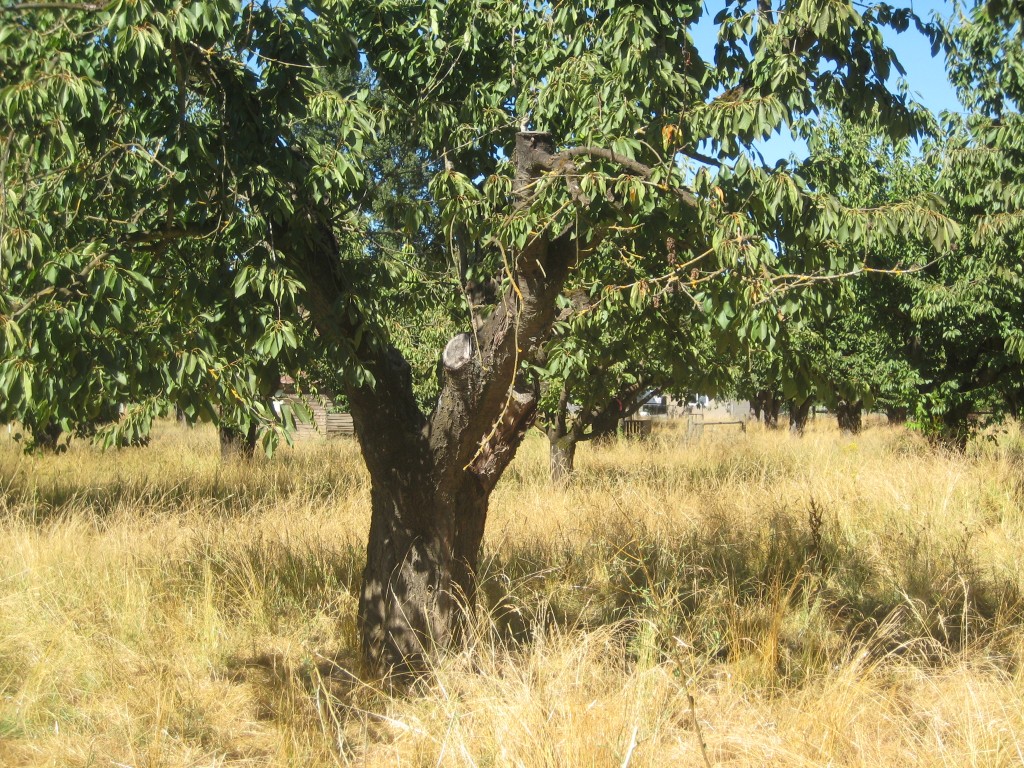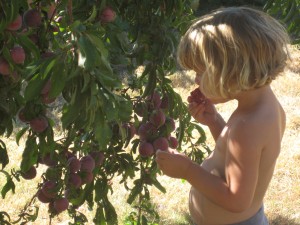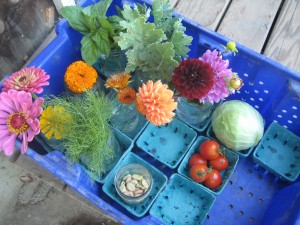
Cherry tree in the orchard. The yellow grass is actually helping new fresh green grass to come up from below (the shade of the tall grass helps the young grass stay alive without going dormant in all this heat), providing fresh forage for some of our hogs.
Hey! Did you see that rain this Sunday? Did you revel in it? Did you go out naked, running and dancing? Ok, Casey and I didn’t do that last thing, but the kids did. Because, WOW, a few drenching showers on a quiet Sunday felt like the Best Thing Ever. The dust cleared; the ground got wet; we relaxed into it and even pulled out some card games after dinner. It felt like quite the Sabbath day gift.
Now, we’re back to Summer-As-Normal — day one into another Willamette Valley heat wave. True to form, this one arrived with blustery Northeast winds yesterday, which blew the kids and me around a bit as we prepared Rusty’s entries to the county fair. This is his first year entering, and we went out in the morning (before the heat) to harvest what we could from the garden. We got the kids’ garden in a little later this year, so no melons yet (alas, much to Rusty’s chagrin), but there were dry fava beans, basil, tomatoes, kale, cabbages, and lots of flowers to pick. He also made a bouquet to enter. Dottie didn’t want to be left out, of course, in spite of being three years younger than the age we waited with Rusty. So she made a bouquet as well, which the fair folks happily accepted into the running. We await our visit to the fair with great anticipation of potential ribbons and prizes (but really it’s just fun to get the kids involved in the wider agricultural community this way!).
In the fields, irrigation continues to be a mainstay. The day always begins with pipe moving, and sometimes ends that way too. If you’ve wondered, irrigating so much is expensive. Our well pump bills get pricey this time of year. More so in a year without June rain, of course. We’ve been irrigating since … April? It feels that way. Perhaps a bit then, and certainly in a solid, sustained way since May.
The landscape of the farm is changing a lot these days, as we simultaneously take care of this year’s crops and begin the ground work for next year’s. Casey has already worked in many of our spring plantings, and we are continuing to irrigate that ground in order to spur on weed seed germination. This process is called a “summer bare fallow.” It’s a useful way to work through the weed seed “bank” that resides in the soil. Just think, in every square foot of soil, many weed seeds can lie dormant, just waiting for their opportunity to germinate and grow up. Some of these seeds can lie dormant for many, many years; and, naturally, a field that has been let to go to weeds in the past will have more seeds in it than one that has been carefully weeded. Weeds happen on our farm. Some years, a lot of weeds happen. And, we’re on Grand Island, where — as one of our neighbor farmer friends likes to say — everything grows well … especially the weeds.
So, we do what we can. We’re hoping to catch up a bit better with the weed part of organic farming in future years, and these sorts of bare fallows are a great start. Once we get a nice flush of germinated weeds in our fields, we can work up the ground again, and those potential future weeds will be gone at least. We’re also ordering some large tarps to try a method called “occultation” — in this scenario, freshly worked, moist ground is covered with a large opaque tarp. The warmth under the tarp (plus the moisture) germinates seeds, and then the absence of light kills those weeds. It’s an expensive method, since large tarps cost a lot of money, but it’s also passive (i.e. doesn’t require as much hands-on work or diesel-fueled tillage to be effective). We’re excited to try some new things and hopefully see good results in future years.
We’re also fully in harvest mode out here now. Most of the summer-specific fruits are “on,” keeping us busy with picking. We loaded up eight bins of cucumbers from the fields yesterday, and that was just one crop! And we will keep picking these plants for weeks to come! This year can be so magical — these “pick and come again” crops seemingly pouring out food, week after week. This is it — the peak of the wave of food. Before too long, we’ll even begin harvest our storage crops. Hard to believe, but fall is just around the corner — in shortening daylength if not in rainfall or cool temperatures yet. This Saturday (August 1) is Lammas, the Celtic harvest celebration that marks the halfway point in our summer season.
I think even we people are feeling that shift now. Even though most of us have at least a month left before school starts again, everyone is suddenly talking of their end-of-summer plans. We continue to visit the river weekly, and yet it feels as though we should now savor each date. A bit premature, really, given how many hot and swimmable days are still to come, but the stirring to harvest and fall storage energy is upon us. It is imminent.
Meanwhile, we continue to dwell in this again dusty and dry valley, carved out of this place by that same flowing river over millennia. The landscape, and the island especially, have been so shaped by this force of water that seems almost wholly absent this time of year. I have to admit that growing up in the Northwest, I was mostly out-of-tune with this place and its seasons. I was not aware until adulthood that we experience seasonal droughts in this region. When this phenomenon was described to me, I can’t say that I met it with pre-existing awareness. To be more fair to my young self, perhaps I was like the fish who doesn’t realize he is wet, because water is all he knows. I must have understood about summer droughts on a deep level, because I still marvel at the notion that in other places, rain falls in the summer. Regularly! So much so that some farms don’t even own irrigation equipment, let alone spend a good portion of every day thinking and working on irrigation projects. How amazing!

Dottie samples some of the first of our next variety of red plum. Not quite juicy enough yet to drip down her chin, but it will happen soon.
And, yet here we are, facing extreme fire warnings as the humidity drops to 10% and the daytime high temperatures rise to above 100° — no rain anywhere on the forecast for who knows how long. It will come. It will. We will welcome it, but for now we relish the unique beauties of this season: the golden sunlight before dusk (made even more so as it shines through all that dust); the deep baking dry heat that can actually feel good — like it is reaching to the bones and drying out any last remnant of moisture or mildew from Oregon winters; and, the fruit — the juicy, mouth-watering endless parade of fresh fruit. Plums. Blackberries. Apples.
I will close with a poem that always resonates this time of year:
The Arrival — Wendell Berry
Like a tide it comes in,
wave after wave of foliage and fruit,
the nurtured and the wild,
out of the light to this shore.
In its extravagance we shape
the strenuous outline of enough.
Perhaps we will see some of you at the fair. Perhaps you will be swimming instead. Stay cool and safe this week. Enjoy this week’s vegetables!
Your farmers, Katie & Casey Kulla
~ ~ ~
CSA payment due! One last reminder that our second-to-last CSA payment is due tomorrow at pick-up! You can bring cash or check! I emailed statements last week, but if you have any questions about your account, please email me! farm (at) oakhillorganics (dot) com
~ ~ ~
Meet this week’s vegetables:
- Red plums — Prepare yourself this week — the plum volume is down from our extravagant amounts in prior weeks. This is because we’re moving onto a new variety that is just coming on (the plums Dottie is sampling in the photo above). We want to give the trees time to ripen more of the fruit, so we just picked enough for each household to get a pint this week. Even though these resemble the Methleys from the outside (red plum), the interior flesh is quite different. Much meatier, which makes sense given that this is a later plum (if you’ve never noticed this trend, later varieties of any fruit tend to have more structure and more complex flavor profiles than earlier bearing varieties which are often more watery and just sweet — it takes time to develop those more complex textures and flavors!). Anyhow, enjoy your sneak peek and prepare yourself for more of these to come.
- Tomatillos — We gave these out last week without putting them on the list ahead of time (we weren’t sure if we’d have enough and hadn’t harvested them yet). Tomatillos have become one of our favorite summer fruits, and we love freezing them for use all winter. The flavor is somewhat like a mixture of tomato and lime. It’s more piquant than tomato and not quite as sweet (at least not until they are ripe and yellow). Tomatillos cook down readily into a sauce (hence “salsa verde,” which is traditionally made with this fruit rather than tomatoes). When we have tomatillos around the house, I often start a meal by chopping them and sauteeing in butter until they are saucy. Then I start adding other veggies (or just use this sauce to season meat).
- Tomatoes
- Peppers — There will be a mix of hot and green bell peppers again this week. I found out that hard way last week that some of our hot peppers are already plenty hot! I neglected to wear gloves when cutting them and ended up with burning hands (and then burning face when I touched it). It turns out that it’s very hard to remove capsaicin from skin — the agent that gives heat to the peppers is an oil and therefore not water-soluble. To some degree it can be removed by rubbing with another oil and then washing, but really just be careful and wear gloves when handling hot peppers. They’re yummy though!
- Beans (green & yellow)
- Chard
- Collards — To us, collard greens are the ultimate summer cooking green. Something about their growth habits of genetics make them better suited to these warmest parts of the year (whereas kale can often become a flea beetle and aphid magnet in the high summer season). Collards can be prepared in the same manner as kale, but they usually take a little longer to cook to reach the same level of softness. Traditionally, in the south, they would boil collards in water for up to an hour. We don’t take it that far, preferring to braise in butter and stock in a pan on the stovetop. But, we do cook until they are fully tender, often eating them at breakfast with eggs.
- Beets
- Carrots
- Cucumbers
- Zucchini & squash
- Potatoes
- Eggs!
And this week’s extra goodies from the farm:
- Eggs — $6/dozen ~ Too hot to cook! Make an omelet for dinner!
- Walnuts — $5/lb
- Lamb — We’ve got lots of fun cuts of lamb in the freezer still! Roasts and chops! Prices vary.
- Beef bones — We still have a few beef bones left! $4/lb
- Ground beef — Or, stay out of the kitchen entirely, and grill hamburgers on the BBQ outside this weekend! $7 for 1/lb packages



